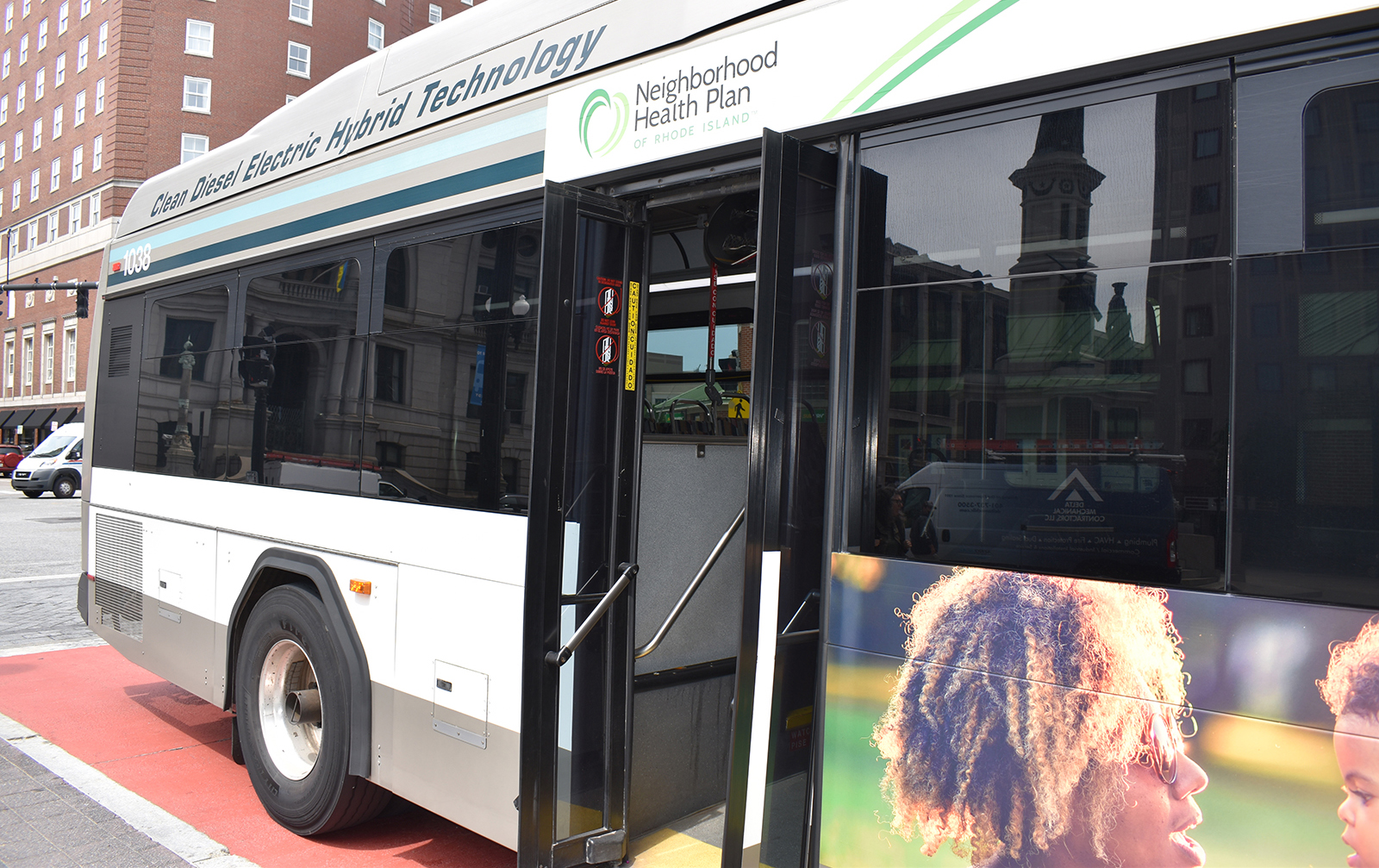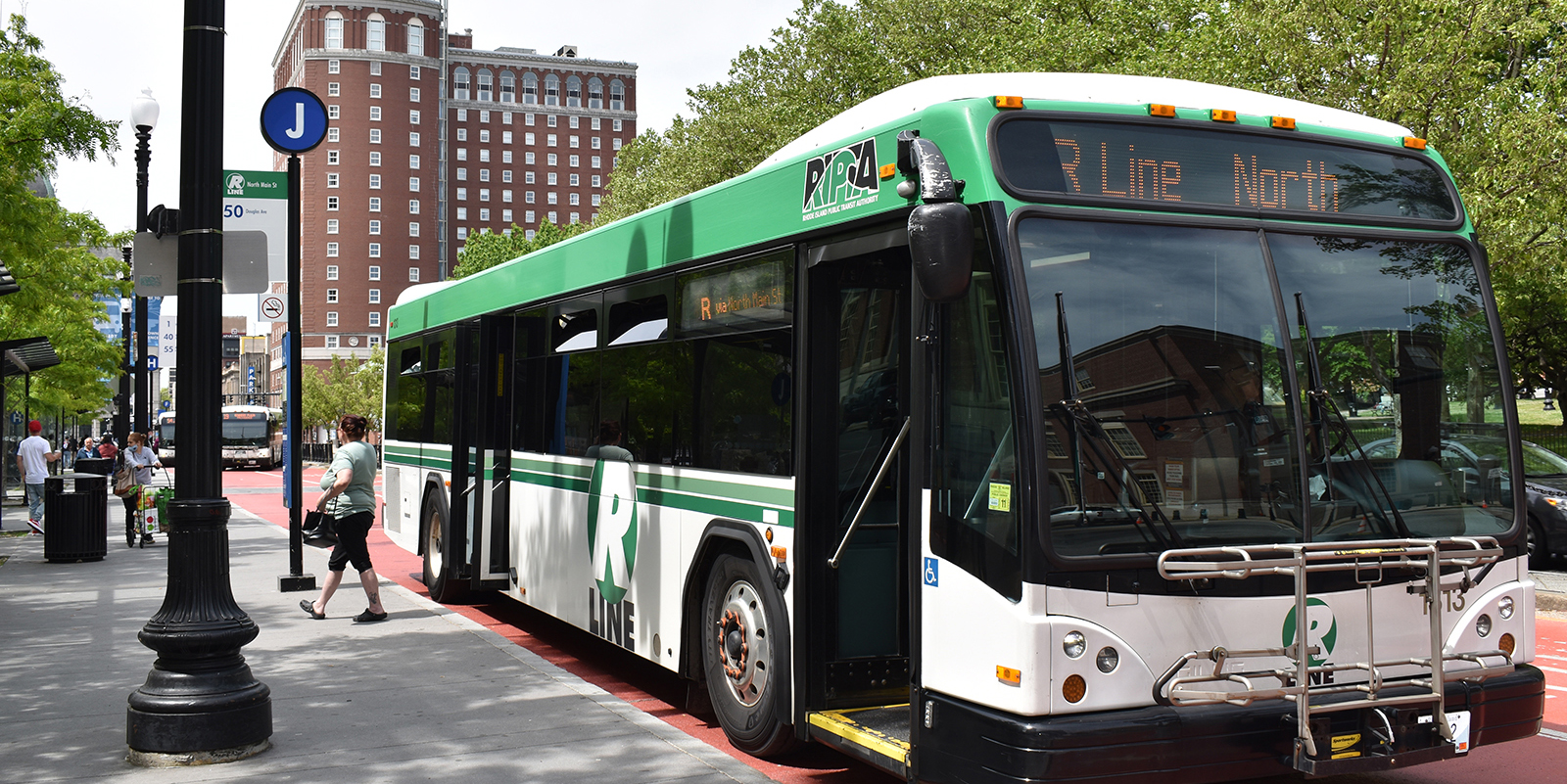Revamped Kennedy Plaza, New Tech Spur RIPTA
February 13, 2015
PROVIDENCE — During the past two years, the Rhode Island Public Transit Authority (RIPTA) has implemented a number of changes to the state’s bus system, including a rapid bus route, improved capacity to offer riders real-time bus information and the highly discussed renovation of Kennedy Plaza.
The R-Line, a rapid bus route designed to alleviate congested local service on Broad Street and North Main Street, began servicing riders in June 2014. The route stretches between the Cranston line to downtown Pawtucket. In order to decrease travel time, lesser-used bus stops were eliminated and a system that coordinates traffic signals with approaching buses was added.
According to Barbara Polichetti, RIPTA’s director of public affairs, travel time on the R-Line has decreased by about 18 percent. Prior to the transition, the route took about 56 minutes to complete; now it takes about 46 minutes. Polichetti said travel time will continue to decrease as the system that coordinates traffic signals with buses is fine-tuned.
Prior to implementation, transit advocates pushed back against the elimination of bus stops along the R-Line. The advocacy group RIPTA Riders Alliance took the position that sacrificing bus accessibility for faster travel times wouldn’t best serve ridership, especially those unable to walk long distances to bus stops. In response to those concerns, RIPTA added two stops to the R-line route, Polichetti said. She noted that there have been minimal complaints about the spacing and location of the stops since the R-Line began running.
However, the quarter-mile spacing between stops remains an issue, according to several RIPTA Riders.
“It has become a winter of discontent, as people have to walk longer, often in the street (because of snow-covered sidewalks), to reach their stops,” RIPTA Riders President Don Rhodes said. He also said R-Line buses are overcrowded, resulting in buses skipping stops where prospective passengers are waiting to board.
“The only way to get on was if someone got off,” Rhodes said of his experience with the R-Line.
According to Polichetti, RIPTA hasn’t experienced an increase in ridership since the launch of the R-Line. She said RIPTA anticipates an increase now that construction at Kennedy Plaza is complete and after gas prices revert to normal levels from recent unusual lows.
Polichetti also said RITPA has no plans to replicate the R-Line elsewhere, but said some features, such as coordinating traffic signals with approaching buses, may be incorporated on additional routes in the future.
That’s the ticket
Ticket vending machines, scheduled to be installed this spring in Kennedy Plaza, will reduce travel time on buses that serve the downtown transportation hub, according to Polichetti. These machines will make it easier and quicker for passengers to board buses, by allowing riders to buy tickets and passes while waiting for their bus. The machines will initially only accept credit cards, but may eventually be programmed to accept cash, Polichetti said.
Additional locations that may receive vending machines include the Providence train station and downtown Pawtucket, she said.
In June 2013, RIPTA announced it would update its buses and many of its shelters to include real-time information via the Automated Transit Management System (ATMS). Since then, all buses have been fitted with hardware to provide automated audio and visual stop announcements to riders. The technology is designed to make riders aware of upcoming bus stops and transfer opportunities.
Real-time bus information is more readily available at Kennedy Plaza. All new shelters in Kennedy Plaza include digital signs capable of displaying real-time information. The signs are mostly operational, according to Polichetti. After RIPTA overcomes any initial glitches, signs will be added to the remaining shelters. Real-time information also is available on a digital display inside the customer center at Kennedy Plaza.
Additional real-time information features highlighted in June 2013 haven’t yet been introduced. The ATMS could conceivably allow riders awaiting a bus to text a bus stop-specific code to a RIPTA telephone number and receive wait-times for upcoming buses serving that stop. Web and mobile applications that would offer real-time bus information are currently under development, according to Polichetti.
Grand reopening
Kennedy Plaza recently reopened, after undergoing a $2.4 million renovation. The construction project decentralized bus stops by relocating some shelters to the periphery of the plaza and eliminating one designated bus lane from the center of the plaza. The new configuration is designed to be more pedestrian friendly and aesthetically appealing.
According to Polichetti, response to the new plaza has been positive. New passenger amenities include improved bus signage, new lighting and three-sided shelters that better protect passengers from the weather. The downtown plaza will also be a shadier place, thanks to the addition of newly planted honey locust and Valley Forge American elm trees.
“The area will be a more appealing public space that can be used for art installations and other community projects,” Polichetti said. “RIPTA is looking forward to seeing these new uses for the plaza evolve when warmer weather arrives.”
Barry Schiller, a longtime Rhode Island transit advocate and a member of RIPTA Riders, describes himself as being “in the middle” regarding Kennedy Plaza’s redesign. Schiller said that for some routes the new plaza provides an improved experience. The No. 57 Smith Street bus, for example, used to load on a narrow island with no shelter — the redesign resolved those issues. Meanwhile, other bus stops, such as the No. 14 Narragansett and No. 66 URI have been moved across Burnside Park, making transfers more time consuming and challenging, especially for less-mobile riders, he said.
Polichetti said there have not been major complaints about the decentralization of bus stops in the newly renovated plaza.
Schiller said many of the improvements in the plaza could have been achieved on the original footprint. Real-time bus information and improved signage could have been added to existing shelters, he said.
The new-look plaza is unlikely to encourage more pedestrian activity, according to Schiller. He said the removal of one designated bus lane makes the plaza wider and more pedestrian friendly, but added that continuing to allow eastbound automobile traffic to cut through the center of the plaza on Washington Street, coupled with the predominantly concrete facade of the new plaza and the continued presence of transit passengers, will dissuade pedestrians from using the plaza.
“Overall, not worth the money and months of disruption,” he said. “But I could be wrong.”
RIPTA’s outreach to educate and assist riders through the transition to the new plaza configuration was adequate, according to Polichetti. Efforts included having staff present in the plaza for several days before and after reopening, printed literature explaining new bus-stop locations, and a web and social-media campaign to inform riders of changes.
“Anecdotal information indicates that it didn’t take most riders very long to become comfortable with the new layout,” Polichetti said.
Rhodes, president of RIPTA Riders, said the old plaza had become dysfunctional because of increased bus ridership. After the renovation, he said, taking the bus to the plaza “is a pleasant experience. Hopefully, it will be taken care of and not become a refurbished version of the past.”
RIPTA is expected to soon begin work on additional improvements to the state’s system of transit hubs. The Gateway Transportation and Visitors Center in Newport will be repaired and redesigned via a $1.6 million grant from the Federal Transit Administration, according to Polichetti. The city-owned facility was built in 1985, and houses the Newport Visitors Center, customer parking, bus berths, bicycle facilities and taxi stands. It was damaged during Superstorm Sandy in 2012. The project will make the intermodal facility on America’s Cup Avenue more resilient to future storms, Polichetti said.
In partnership with the Rhode Island Department of Transportation, RIPTA will also begin developing a network of transit hubs in Providence to alleviate congestion at Kennedy Plaza. The project will be funded by the $35 million bond passed by voters last November. The work will create new transportation hubs at the train station in Providence and at the Garrahy Judicial complex, according to Polichetti.




I’m a daily rider and appreciate the improvements. I also think that diversifying the use of Kennedy Plaza will prove to be a good thing for the city and for for riders. I think the improvements will attract more people to use transit. John Flaherty
originally there was talk of a kennedy center that would be like a town square, with open air markets,farmers markets, cafes and concerts………………which sounded wonderful……now I hear they are hoping for art installations and community projects……….sounds like this grand plan has fallen by the wayside, unfortunately…………………….altho it seemed ridiculous that people would come to be at kennedy plaza because it already is a hang-out for too many people
the upcoming planned rhode island publick mmarket would be a real coup but kennedy plaza does not seem to be in the running or this
but not to worry, if the bus shelters are not cleared out, no one will get there anyway….
I see some improvement with the new layout EXCEPT Exchange St., which is now a dangerous accident waiting to happen. People who do not realize it has become a two way street since the renovations speed up the street to get out of town at 5 p.m., crossing the yellow line to get around two lanes of traffic. Because there is no light there at the post office, gridlock occurs with traffic coming from four directions.